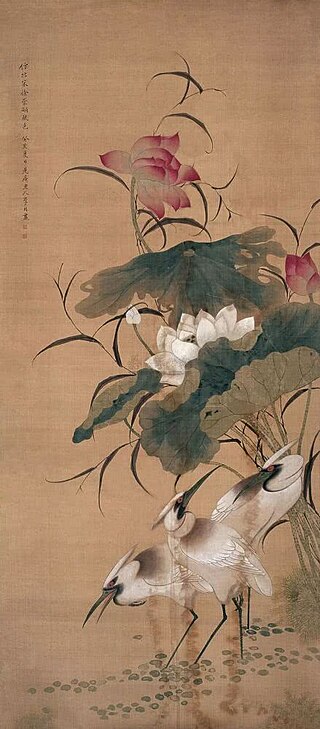
Luo Ping was a Chinese painter of the Qing Dynasty who lived in Ganquan (甘泉; present-day Yangzhou, Jiangsu. His courtesy name was Dunfu and his pseudonyms were Liangfeng and Huazhisi Seng. He studied painting under Jin Nong and developed a unique personal style. He painted people, Buddhist images, plum with bamboo, flowers, and scenery paintings. He refused government service to live a life of poverty selling paintings. He was the youngest of the Eight Eccentrics of Yangzhou.
Ah Toy (Chinese: 亞彩; Sidney Lau: Aa3 Coi2; 18 May 1829 – 1 February 1928) was a Chinese American sex worker and madam in San Francisco, California during the California Gold Rush, and the first Chinese sex worker in San Francisco. Arriving from Hong Kong in 1848, she became the best-known Asian woman in the American frontier.
Liu Qingyun, courtesy name Guxiang, was a Chinese playwright and poet. She has been described as "the most prolific woman playwright of the nineteenth century".
Wang Cong'er was a female Chinese leader of anti-Manchu White Lotus Rebellion along with Wang Nangxian during the reign of the Qing dynasty.
Fu Daokun, was a Chinese painter during the Ming Dynasty. She was famed foremost for her skill as a copyist and her technique in Chinese Painting. She was, together with Fan Daokun, one of only two female artists to be recognized by her contemporaries as elite artists.
Kong Sizhen, was a Chinese military commander and princess.
Hong Xuanjiao, also known as Yang Yunjiao and Yang Xuanjiao, was a Chinese female general and rebel leader during the Taiping Rebellion. She was said to be the younger sister of the leader of Taiping Heavenly Kingdom, Hong Xiuquan, and is the wife of Xiao Chaogui, the West King. She led women into the battlefield against the Qing dynasty for the Taiping cause.
Wang Nangxian was a female Chinese leader of the anti-Manchu White Lotus Rebellion along with Wang Cong'er during the reign of the Qing dynasty. Another female member of the rebellion along with Wang Cong'er, she declared herself divine and commanded her own troops in battle against the Imperial army. She was called 'Sorceress Wang' due to her use of 'magical powers' as a blessing for their strength, power and dignity towards her troops including Wang Cong'er and many other Chinese residents during ritual ceremonies.

Lin Hei'er was a Chinese rebel during the Boxer Rebellion, known as the Holy Mother of the Yellow Lotus. She was a prostitute and acrobat with martial arts knowledge who became a member of the Yihetuan. During the Boxer Rebellion, she organized and commanded the Red Lantern unit of female soldiers in Tianjin.

Fang Junying (1884–1923) was a Chinese revolutionary.
Cai Wan (1695-1755), was a Chinese poet.
Cao Zhenxiu was a Chinese author, poet, calligrapher, and painter.
Gu Mei, better known by her art name Gu Hengbo, also known as Xu Mei and Xu Zhizhu after her marriage, was a Chinese Yiji, poet and painter. She received the title "Lady (furen)" from the early Qing court, and often addressed as "Lady Hengbo" in Qing writings.
Chai Jingyi, was a Chinese poet and painter. She produced two collections of poems, and was also known for her paintings of flowers. She was a member of the aristocracy and the daughter of Chai Yunqian, sister of Chai Zhenyi, spouse of Shen Hajia, and mother of Shen Yongji and Shen Zazhi. She was the chairperson of the famous women's literary club Jiaoyan qizi.
Cai Han, was a Chinese landscape painter. She was the concubine of the painter Mao Xiang and, with his other concubine Jin Yue, she was commissioned by him with the task of producing paintings as gifts to his guests; they became known as "The Two Painters of the Mao Family".
Ding Yu, was a Chinese painter. She was married to the painter Zhang Pengnian (1761–1818) and was known for her portrait paintings in the Western style.

Yun Zhu or Wanglan Yun Zhu aka Adept of the Lotus Lake was a Qing dynasty poet, painter, anthologist and moralist. She gathered together thousands of poems written by hundreds of women.
Lin Yining, courtesy name Yaqing, was a Chinese poet active during the Qing dynasty. A founding member of the Banana Garden Poetry Club, Lin Yining was also an avid painter and composer.

The Eight Beauties of Qinhuai, also called the Eight Beauties of Jinling, were eight famous Yiji or Geji during the Ming-Qing transition period who resided along the Qinhuai River in Nankin. As well as possessing great beauty, they were all skilled in literature, poetry, fine arts, dancing and music.

Li Yin, also known by her courtesy name Jinsheng (今生) and her art names Shi'an (是庵) and Haichang Nüshi(海昌女史) or kanshan Yishi(龛山逸史),was a Chinese Gējì,painter,poet and calligrapher during the late Ming and early Qing dynasties, noted for her flowers and birds. Her artwork was sought after in her lifetime, resulting in as many as forty imitators in her area producing fakes of her works.





